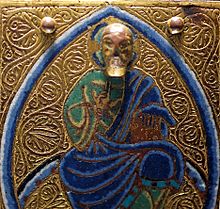
Back Reliquienschrein German Châsse French Relieksjrien LI Reliekschrijn Dutch Ковчежец Russian Relikskrin Swedish



A chasse, châsse or box reliquary is a shape commonly used in medieval metalwork for reliquaries and other containers. To the modern eye the form resembles a house, though a tomb or church was more the intention,[1] with an oblong base, straight sides and two sloping top faces meeting at a central ridge, often marked by a raised strip and decoration. From the sides there are therefore triangular "gable" areas.
The casket usually stands on straight stumpy feet, and there is a hinged opening to allow access, either one of the panels, but not on the front face, or the wooden bottom; there is usually a lock.[2] The shape possibly developed from a similar shape of sarcophagus that goes back to Etruscan art, or from Early Medieval Insular art, where there are a number of house-shaped shrines, reliquaries or cumdachs ("book-shrines"), with similar shapes. The Monymusk Reliquary is typical of these, having four sloping panels above, so no "gables". A 13th-century example of the fully-sloping type is the chasse of Saint Exupère in Limoges enamel (see gallery of images, below). The word derives, via the French châsse, from the Latin capsa, meaning "box".[3]
© MMXXIII Rich X Search. We shall prevail. All rights reserved. Rich X Search